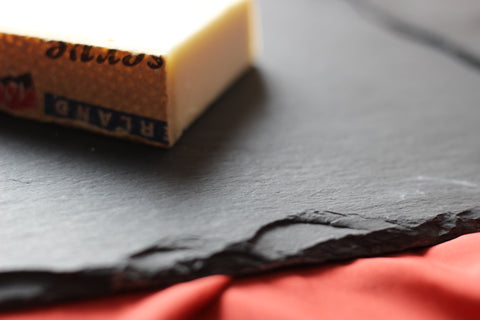There are a variety of beautiful, natural materials used for storing and serving cheese. Before refrigeration, cheese caves employed natural, local materials to keep cheese cool, out of the sunlight, and ultimately thriving as tasty, ripening wheels and blocks of cheese. Many of the methods of cheese ripening are attributed to natural materials such as wood, slate, marble, limestone, and clay. At a future date, I will do a deep dive into these materials and the variations between them, but today we will cover the basics!
Wood
Wood and cheese: a match made in heaven. Natural cheese has been aged and stored on wood for centuries, as it was the only local material available. Wood’s porous nature helps maintain humidity without condensation and also helps cultivate the particular ambient cultures necessary for different styles of cheese.
Clay
Clay pots and clay forms have been used traditionally in cheese making practices for hundreds of years. In French cheese making, clay pots are often used to house the “mother culture,” which is teeming with delicious, flavorful microbes that give a cheese its distinction. Often, a portion of this mother culture is mixed into the milk before cheese making. Why use clay, apart from the fact that it is an accessible, natural material? The porous nature of clay actually creates an amazing climate for cheese microbes, while preserving the humidity necessary for microbes to thrive. The microbes cling to the wall of the clay pots, making it easy to thicken and sour newly added fresh milk. The ‘mother culture’ will survive for years in the wall of the clay! For the Cheese Grotto storage line, we focus on clay’s ability to hold moisture and an ambient humidity level.
Limestone

Limestone is a famous cave material of the Roquefort-sur-Soulzon. Nestled in the nooks and crannies of these caves is the natural blue mold that makes Roquefort cheese so distinctly delicious. Various stones in different regions of the world have a similar effect on cheeses. The stone walls of a cave, which keep the the cheese naturally cool and humid, also contribute to the final flavor profile of the ripening cheese. This Roquefort cheese episode by Will Studd is excellent viewing to learn more.
Slate
Slate is all the rage these days. “It is a fine-grained, foliated, homogeneous metamorphic rock derived from an original shale-type sedimentary rock composed of clay or volcanic ash through low-grade regional metamorphism. "It’s a great serving board for cheese, and you can write on it, too! Slate also has a similar effect on cheese as limestone and clay. It is a naturally cooling material that also holds moisture in order to maintain humidity.
Marble

Marble is classic, clean, and pristine for cheeses. It is not porous like the other natural materials, but it is naturally cooling, making it a great shelf for serving and storing wedges of cheese.
These options are only the beginning. It makes me want to design more models of cheese storage that are both naturally beautiful and functional.




Leave a comment